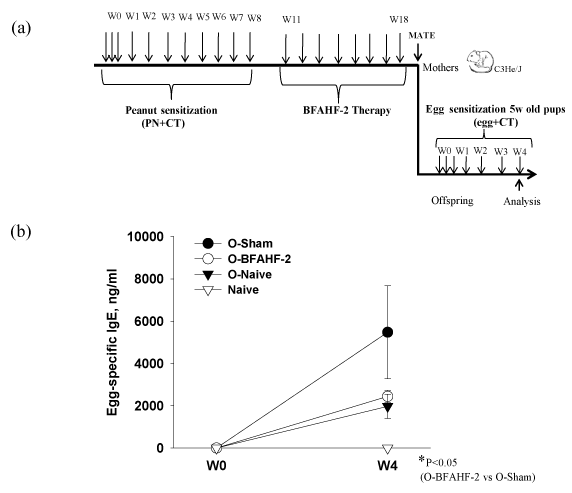
A: Maternal peanut consumption provides protection in offspring against peanut sensitization [23]
Left: Experimental protocol of mothers’ and offsprings’ peanut (PN) sensitization. Female C3He/J mice were fed either with peanut and cholera toxin ig (PN+CT), peanut ig (PN) or cholera toxin alone (CT) for five weeks and, after mating with naïve males, during pregnancy and lactation. An unimmunized group was employed as a control. 5-week old offspring from all the 4 groups were sensitized with PN+CT i.g. weekly for 5 weeks followed by 2 boosting doses. Mothers were sacrificed at weaning and offspring at week 15 for analysis.
Right: Peanut-specific immunoglobulin levels in mouse milk: peanut-specific IgG2a (ng/mL), peanut-specific IgG1 (ng/mL) and peanut-specific IgA (ng/mL) measuredby antigen-specific ELISA. Data are expressed as means ± SEM of duplicates for each group (n=3–4) *P<0.05, ***P<0.001 vs Unimmunized.
B: Transfer of specific immunoglobulin by breast milk leads to antigen-specific offspring protection from food allergy [26]
Left: Experimental protocol. Sensitized mice were exposed to 1% OVA in drinking water for 2 weeks immediately after delivery. Offspring were weaned at 4 weeks and 5-week-old offspring were used for the FA model.
Right: OVA-specific IgG1 and IgA levels in breast milk. OVA-specific IgG1 is only found in the breast milk from OVA-sensitized mothers, which implies that mother micesecrete IgG1 into their breastmilk. OVA-specific IgA is only found in the breastmilk from OVA-sensitized and OVA-exposed mothers. Data are shown as the means and individual data points. N.D.: not detectable. *P<0.05, **P<0.01, n=5–9.